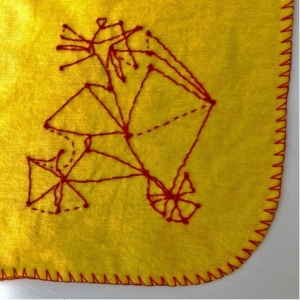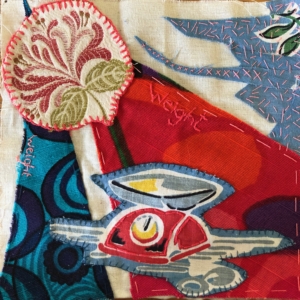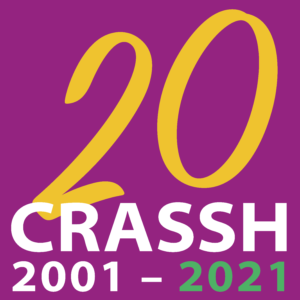The Thread: A Journey of Work
Welcome to the Tactics and Praxis conference blog. We hope it will capture the thread of conversations that run throughout this week, building a sense of community, sharing and support in the absence of physical interaction.
Annabel Barber
Reclaimed

My contribution is unfinished and titled ‘reclaimed’. It’s a synthesis of silk velvet tumbling blocks patchwork from a cushion cover of my mum’s, a doiley (possibly tatted, maker unknown), and found objects, including a large washer that I spray painted through lace, and glass beads from a charity shop jumper. The photographs of the anonymous women have been printed onto fabric, the original photographs came from the same seaside junk shop as the doiley. I wanted the piece to give some recognition to women’s expressions of creativity.
It connects with the conference for me in several ways. It reminds me that my horizons are wider, and that I have the opportunity to use my creativity in different ways, including (albeit belatedly) in the academic arena. My main original contribution to the piece is the quilting, which has echoes with the ‘doodles’, from the decoration workshop/seminar. This seminar also reassured me that there was (probably) validity in trying to explain one of my research questions to my supervisors in terms of a children’s book (The Dragon’s Purpose)!🙂
It takes a lot of small stitches to make anything. This piece draws together stitches from different hands to produce something new that, together with new input, can challenge our thinking. A bit like research!
Georgina Evans
Sorry/Not Sorry

I made this square while reflecting on all the uses of the word ’sorry’ over the past year or so. There were so many times when my emails to and from both students and colleagues involved apologies for not being able to do the things we usually would, or having run out of capacity to do something, when people were all suffering from multiple forms of extra pressure. Two of my wonderful students declared our supervisions a ’sorry free’ space at one point. That didn’t mean we suppressed all the things we regretted and wished we could change, just that we avoided using that word in haste and gave those things the space and attention they sometimes needed. That is why the word is broken down in the collage. The word ’sorry’ has also been shared so often in sympathy, for the bereaved, and to the friends, students and colleagues who find themselves in distressing and difficult circumstances of so many different kinds. There have been many insincere ‘sorries’ in the public sphere, but many deeply felt ‘sorries’ sent from one person to another. The collage is made from domestic food packets, so much part of the day to day lockdown space.
Bethan Habron-James
I decided to send in an offering to the Tactics & Praxis Quilt at the last minute before ‘closing time’. The concept had captured my imagination from the outset but life became too challenging during the conference and I found myself unable to focus and be fully present. As an act of self-care, I told myself that making a patch for a quilt was one thing I could release from my ‘to-do list’. But at the back of my conscientious mind there was an ever-present sense of regret and disappointment, mainly due to the fact that this wonderful community of practitioners has been one of my covid gifts and source of wellbeing during the last year and a half. A thread on Twitter had caught my attention, which inspired me to make contact. Online gatherings enabled me to access the presentations, spanning a wide range of stimulating topics and research areas. As a musician and arts-based researcher who is currently exploring various forms of ‘making’, I experienced a tangible sense of home-coming, as I hovered at the edge of this warm-hearted community.
Bricolage, collage and stitching have all been at the heart of my autoethnographic doctoral research as I seek to make sense of the story of my musician’s body in relation to a particular pedagogy called Dalcroze Eurhythmics – an embodied, physical approach to music education and performance. As I peeled back the layers of my lived experience, I gained a window of clarity into my relationship with the violin, which had become my professional instrument. Through somatic exploration I came to understand the complexity of my body and the stories that had been carefully stored and guarded within my ribcage since childhood. As a means of excavating, then accepting, hidden trauma I decided to play around with materials. My intuitive hunch hinted at stitching my relationship with the violin back together. I scanned old photographs and cut my violin-self / violin out, using either the remaining silhouette or the under-side to represent one half of the relationship. Since string instruments share anatomical vocabulary with the human body (neck, belly, ribs), I wanted to exploit these commonalities, particularly focusing on the ribs. Constriction of the ribcage contributes to a lack of resonance in the violin’s own ribs, affecting tone quality. Through the act of folding paper and stitching I explored the various relationships that these two elements could afford, creating a new intimacy, which extended beyond the visual to a visceral sensation. My research journey attests to the fact that imagining and crafting new possibilities such as these can have a transformative effect on one’s own resonance as a musician, both metaphorically and physically.


Vanessa Marr
My contribution to the collaborative conference quilt is an embroidered version of a drawing that I made to visually express my experience of research. It’s a sort of visual map of my brain. I have made French knots to embody periods of intense focus, which are joined by pathways of stitch. I tend to dart around from theory to practice and back again, so these lines represent the journey of my investigations.
My creative research practice uses a humble yellow dusting cloth as an embodiment of the female domestic experience and a catalyst for expression, with red thread to represent femininity. For this reason, I choose to present my quilt patch on the corner of a duster.



Isabelle McNeill
Weight

I made this square during the period of marking undergraduate exams and coursework, and postgraduate dissertations, in my field of modern languages, literature and film. During this period, which spanned eleven days including weekends, I read hundreds of thousands of words (about 300,000 in fact). The hardest thing was to find enough energy to keep going: I drank a daily energy drink I discovered in the student coffee shop, and ate far too much sugar. I asked some colleagues how they kept their focus and the answer was unequivocal: rewards. I began to reward myself with 5 minutes of creative play – with fabric, needle and thread – for each milestone completed. Sometimes it was 1 minute, sometimes it was 10 minutes. Sometimes I dealt with emails instead. But it helped.
I got out a calico square and some scraps of vintage fabric I’d stashed away for the previously-planned, in-person 2020 Tactics and Praxis conference. Louise had brought the squares round and one Wednesday afternoon when we had a million other things we were supposed to be doing, and Louise, Georgina and I had met, pulling out the fabrics from their plastic bag (I bought them on eBay) and imagining them taking on new forms; playing with colour and line and what could take shape in a square frame through a process of collaborative play.
Now, in a state of examining-induced exhaustion, I took out bits and pieces, cut them up, arranged them; a collage took shape. A fussy-cut pair of kitchen scales from some 1950s fabric found its place amongst the pieces. I started thinking about weight: weight was very much on my mind in the examining process. It’s a process of weighing up: reading and thinking, deciding what counts, what has substance. Is the argument weighted down, grounded in appropriate examples and argumentation? Weight and value go hand in hand. Whose voice has weight, I began to wonder? What kinds of sources have the right kind of weight? Is weightlessness superficial? Might an essay be rewarded for being as light as a feather and as beautiful – as useful?
I also thought about this activity of playing, making, stitching: what weight did it have or should I give it? Did it count for anything? I thought about the weight we accord to different activities in our lives. I was not seeing much of my children or my partner. When I did get home, late at night, or stop working at the weekend, I was tired and irritable. I was giving another responsibility more weight than them – and they felt it. It was a far cry from the domesticity evoked by the 1950s weighing scales. I didn’t crave that though – I just wanted more balance, a more even weighting. Then again, there are different moments for different things. On other weekends, I am watching movies or cooking or gardening with my children, or we are playing board games or taking silly photos on snapchat or going on a bike ride, or going to the park – and at those times I am not working; not seeing students, or marking essays, or writing Very Important Research Things. It is all a balancing act. In French, scales are la balance. I tip one way, then another.
Stitching this little collage helped me to get back to my body when my mind felt saturated, and helped me to remember that I existed when inhabiting over and over again the words and thoughts of others. It has no weight, but still, it has its own way of thinking.


